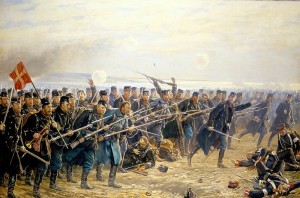This post has kindly been written for us by our IHR Digital intern Brandon Fathy
One of the less well known (and more underrated) online resources for historians is Connected Histories. Connected Histories is a comprehensive search engine comprising a variety of digitised documents and images dating from 1500 to 1900, drawing from 25 different resources ranging from British History Online to the Victoria County History. The site also allows you to create ‘connections’, which are essentially topics that you or anyone else can then add and save items to.
To demonstrate how useful Connected Histories is as a resource, I made a general search for ‘Denmark’ which found 189,007 matches across 22 resources. From here I grazed the results and discovered a variety of interesting items, including correspondence from 16th-century Scotland visiting the king of Denmark on BHO, a plan of attack by the British Navy of Copenhagen from the British Museum, and even a timetable of regular steamboats travelling from London to Copenhagen in 1889 from 19th Century British Pamphlets.
My particular personal historic interest in Denmark lies before the date range of the search engine, but I am also generally interested in the relationships between Northern European countries, so I decided to look at the relationship between Denmark and Queen Victoria. I made an advanced search for ‘Queen Victoria’ in the people index, ‘Denmark’ in the place index, and narrowed the search to 1830 – 1900. By doing so I arrived at a mere 4,154 matches across 6 sources. Many of the newspaper and pamphlet results displayed dated from 1864 concerning a “Schleswig-Holstein Crisis”. I had previously heard of a German invasion of Schleswig sometime in the 19th century, but before coming to Connected Histories I knew very little about it, and had not even considered that Britain may have been indirectly involved.
First I found a newspaper from 1864 that referred to King Christian of Denmark as “Pretender to the crown of Schleswig-Holstein”. I then found a 19th Century British Pamphlet that was concerned with “certain anonymous articles designed to render Queen Victoria unpopular” that referenced an article that had accused Victoria of being unwilling to intervene on Denmark’s behalf because she was a German sympathiser who was feeling especially sentimental because her German husband had recently died. These sources gave me a better understanding not only of a corner Anglo-European relations, but also of popular British attitudes towards both Denmark and Victoria. Furthermore, I was able to read ‘Official documents’ from 1864 stating that there were diplomatic reasons that the queen preferred to marry the “lamented late Prince-Consort” than the Danish king, which was a surprise to me. Shortly afterwards, I read an 1862 newspaper article announcing that Victoria had just sent a formal letter to Princess Alexandra of Denmark soliciting marriage to the Queen’s son Prince Edward, which complicated my perception of the relationship between Britain and Denmark.
This was just preliminary research, but it is clear to me that Connected Histories gave me access to historical materials that a Google search simply could not have, while also providing a richer and overall more complex picture of the Schleswig-Holstein Crisis than I would have been able to see using any one resource like 19th Century British Pamphlets or British Newspapers, on their own.

